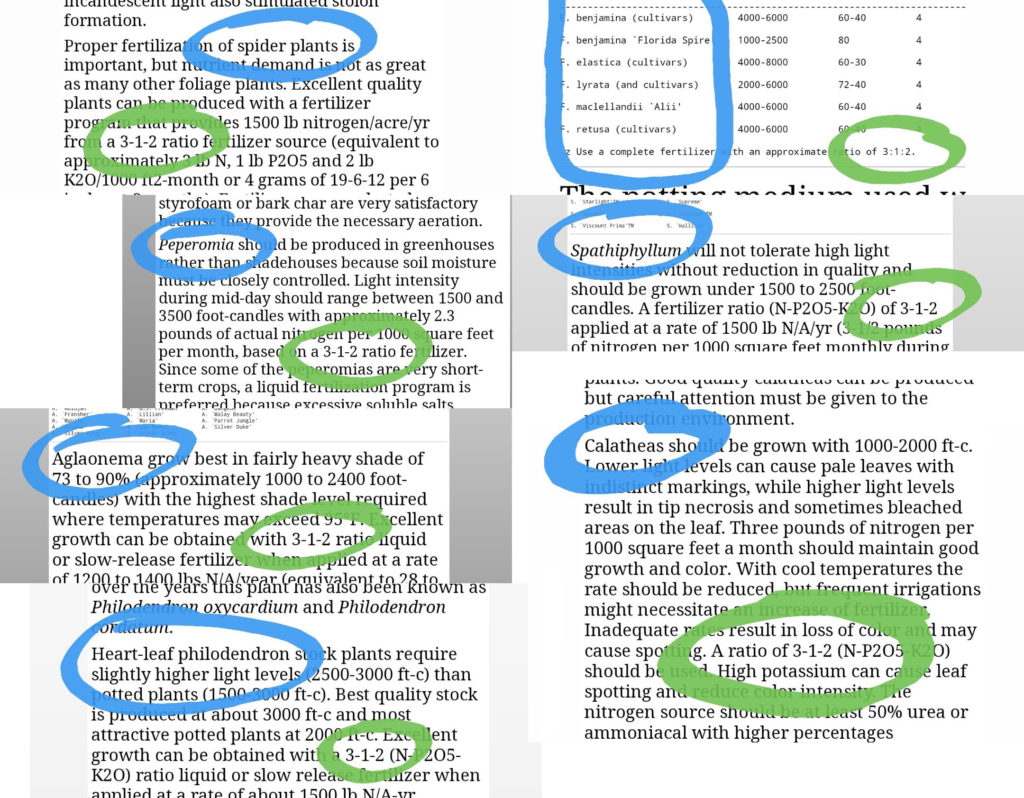When your houseplants get adequate light, they will use up water and soil nutrients. You replenish the water by regular watering but nutrients gradually get depleted from the soil.
Light drives the production of sugars, which are made from water and carbon dioxide but the physical plant structures and all the cell processes require other elements:
Macronutrients (required in greater amounts): nitrogen (N), phosphorus (P), potassium (K), calcium (Ca), sulfur (S), and magnesium (Mg)
Micronutrients (required in smaller amounts): iron (Fe), boron (B), chlorine (Cl), manganese (Mn), zinc (Zn), copper (Cu), molybdenum (Mo), and nickel (Ni)
While all plants require all of the macro and micronutrients, they need them in different amounts – and through years of plant cultivation, professionals have a good sense for what ratios are best suited to different types of growing.
The standard way to characterize a fertilizer is by its NPK ratio – the relative proportion of nitrogen (N), phosphorus (P), and potassium (K) while the rest of the nutrients may or may not be present (you’ll have to read the label in more detail).
You can remember what NPK does for a plant in a general sense by remembering: “up, down, and all-around.”
• UP: Nitrogen mainly supports healthy foliage/stem growth – parts of the plant that are up, above the soil.
• DOWN: Phosphorus mainly supports healthy a root system.
• ALL-AROUND: Potassium mainly supports overall plant cellular functions.
Maintaining houseplants is a relatively easy growing task compared to agriculture or more specialized plants. While other disciplines of growing may require different fertilizers for different applications, the fertilizer NPK ratio that you can use with ALL your houseplants is 3-1-2.
By the way, if you want to learn houseplant care in a way that just makes sense, check out my online course – less blindly following rules; more logical understanding of plants and enjoying their ups and downs.
Just look at what these professional guidelines say for various houseplants (circled in blue)
All NPK ratios are 3-1-2 (circled in green):

That means any fertilizer with multiples of 3-1-2 (or close to that) will be suitable.
• 24-8-16
• 9-3-6
• 11-3-8
Any of these will work just fine for ALL your houseplants. Other “genres” of plant-hobbies might have different fertilizer requirements but I can attest that I’ve only ever used a 3-1-2 fertilizer with satisfactory results. I’m not using different fertilizers for different plants!
How much to use? Assuming your plants have adequate light *, just follow the mixing directions for each product. My preferred method of fertilizer application is by mixing into water – so when I say “I fertilized the plant”, it means I added some fertilizer to the water I used to water the plant. You may have heard to dilute to half or a quarter of what’s recommended, which is fine if your light conditions are poor. In terms of what I personally do, I use my fertilizers at the recommended strength. On the other hand, don’t make the mixture stronger than recommended thinking it will do more good to the plant!
(* Light requirements for different plants – because you actually do need to be more precise with light)
When to use? Here’s where I differ from what’s usually stated – the advice to only fertilize in spring and summer is a rule that’s based on the assumption that your houseplants are only actively growing during the spring and summer. But if your plant is pushing out new leaves, that is active growth and should be supported by using fertilizer. So the guideline should really be understood as “fertilize when there is active growth” – if that happens in the middle of winter, so be it. Plants grown exclusively indoors will not necessarily be actively growing only during spring and summer!
What to use? Fertilizer availability varies around the world so I’ve included links to any 3-1-2 fertilizers I could find (and a few I’ve used) – but in case you don’t find any here (and you only grow “typical” houseplants), just look for anything with multiples of 3-1-2 (or close to it).
Disclaimer: this article contains affiliate links that help to support House Plant Journal content ~ Thank You!
• Osmocote Smart Release Plant Food 15-9-12
• IndoOne – All Purpose Premium Liquid Plant Food 3-1-2
• Dyna-Gro Foliage Pro 3-1-2
• MiracleGro All Purpose Organics 11-3-8
• Fiddle Leaf Fig Tree Fertilizer NPK Ratio 3-1-2
Fertilizer usage is just a small (but important) part of the overall picture of houseplant care. Once you understand how it all fits together with light and watering, you’ll discover just how enjoyable houseplants can be!
‘Essentials of Houseplant Enjoyment‘ is an online course designed with a more logical and sensible approach to houseplant care – not just do’s and don’ts and hoping for everlasting perfection.
‘The New Plant Parent‘ is the book I wrote to help plant parents make sense of houseplant care.